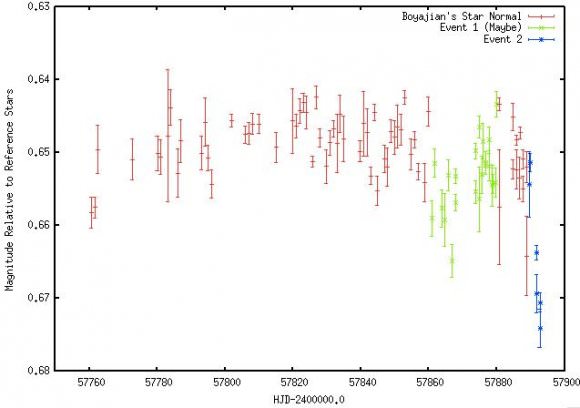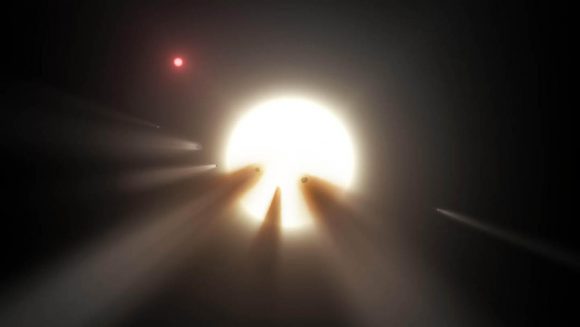In September of 2015, scientists announced that the star known as KIC 8462852 (aka. "Tabby's Star" or "Boyajian's Star") was experiencing a strange dip in luminosity. At the time, astronomers indicated that this mysterious behavior could be the result of comets transiting in front of the star, but other (perhaps more hopeful) individuals claimed that it could also be the result of an alien megastructure.
This led to a flurry of studies and articles that sought to offer entirely natural explanations for what has been observed. Even SETI weighed in, indicating that they would begin searching for indications of radio signals coming this mysterious star. But after two years and multiple studies that offer explanations other an alien Dyson Sphere (or some other type of megastructure), the star is at it again!
The first indications that the star was dimming again were reported late last month by the Fairborn Observatory in Arizona. The robotic telescope spotted what might be a dip in brightness on April 24th, 2017. Within a week, the brightness returned to normal levels, but the event (known as "Event 1" in the star's light curve, shown below) caught the interest of astronomers around the world.

Preliminary analysis of incoming data of KIC 8462852, showing the apparent dip. Credit: Matthew Muterspaugh/Tennessee State University/CEISEM
Then on May 18th, a more significant drop began, which prompted the observatory's scientists to put out the call to observatories around the world to begin turning their telescopes to Tabby's Star. According to the alert issued by the Observatory, the star had already dimmed by 2% after just one night of observation. As soon as the Sun set in their respective regions, observatories around the world began monitoring the star and recording its light curve.
This included the Center of Excellence for Information Systems Engineering and Management (a research laboratory at the University of Tennessee), the W.M. Keck Observatory in Manau Kea, the American Association of Variable Star Observers (AAVSO), and the MMT Observatory in Arizona (which has been providing additional spectroscopy).
The Las Cumbres Observatory Global Telescope Network (LCOGT), which was regularly monitoring the star already, also joined the observation party. While this was happening, Tabetha Boyajian (for whom the star is named) called Jason Wright - an associate professor of astronomy at Pennsylvania State University - to tell him the news. Wright received the call on Friday, May 19th, at 4 a.m., at which point, he was told that the dimming had reached 3%.
Wright then tweeted the news out 24 minutes later (4:24 a.m. EDT) to let the world know that the most mysterious star in the known Universe was acting up again! Hours later, Wright and SETI Director Andrew Siemion also held a live webcast to update the public on everything that was being learned and to explain precisely what the scientific community was looking for.
As Wright said during the course of the webcast, which began at 2 p.m. EDT (11 a.m. PDT), the goal here is to obtain a "spectral fingerprint" from the star:
"Tabby's star... went through a lot of very strange dimming events that got up to 22% dimmer during the Kepler Mission, and since then we've been eagerly awaiting another dip. And the reason that we've been waiting for that is that whatever is causing the star to get dimmer will leave a spectral fingerprint behind. So if it's a lot of dust between us and the star that's passing by, it should block more blue light than red light. If there's gas in that dust, that gas should absorb very specific wavelengths. So we've been eager to see one of these changes, these dips in the star, so we can take the spectra.
In other words, if we're dealing with entirely natural phenomena - like clouds of debris, comets, a consumed planet or anything other than an alien megastructure - that will become clear from the spectra we obtain from the star. If, however, the spectra does not conform to these parameters, we will once again be back to speculating about the possible cause. And you can bet your bottom dollar the alien megastructure crowd will be out in full force!
As Wright went on to explain, during the preceding week, there were indications that something was happening around the star. However, none of it was significant enough for observatories to go from "yellow alert" - i.e. in a heightened state of readiness - to actively training their telescopes on the star. The reason for this is that telescopes have their observation time scheduled weeks or even months in advance.

Artist's impression of an orbiting swarm of dusty comet fragments around Tabby's Star. Credit: NASA/JPL-Caltech
As such, no one can hit the override button and demand that their telescopes be trained on a new target without having a very good reason. However, on Thursday, the staff at Pennsylvania State University were waiting for data that would indicate if the dip was really happening. By Friday, in the early morning hours, that is precisely what they got! As Wright recounted during the broadcast:
"[At] about 4 a.m. this morning I got a phone call from [Tabitha Boyajian] that Fairborn Observatory in Arizona had confirmed that the star was 3 percent dimmer than it normally is. That is enough that we are absolutely confident that this is no statistical fluke. We've now got it confirmed at multiple observatories, I think."
So far, several observatories have provided spectra that indicates that the star really is in the process of dimming. And in the coming days and weeks, additional observatories are expected to join in. This may include the Green Bank Observatory, which will collect radio observations, and even space-based observatories like the Swift Space Telescope - which will provide both optical and ultraviolet data.
Regardless of what they find, you can expect we will be hearing about shortly thereafter! And in the meantime, be sure to check out the full live broadcast below:
Further Reading: Sky & Telescope
No comments:
Post a Comment